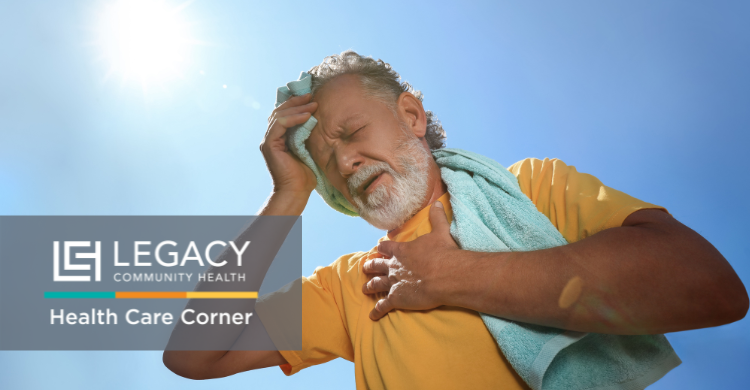By Ashley Guidry, Communications Associate
Extreme heat is one of the top weather-related killers threatening the most medically vulnerable in the United States. How can Houstonians prepare against this deadly heat?
A devastating storm hit Houston on May 17th, resulting in at least seven deaths, along with nearly a million residents and multiple schools without power for several days. With temperatures rising, air quality worsening and humidity elevating, the lack of power heightens heat safety concerns.
Understanding Heat-Related Illnesses
Data from the Texas Department of State Health Services shows 334 people died in Texas last year due to heat-related illnesses. Heat cramps are the first sign of heat-related illness and can lead to heat exhaustion or stroke. Symptoms include painful muscle cramps, spasms and heavy sweating. If cramps last longer than an hour seek immediate medical attention.
Someone experiencing heat exhaustion may show these signs:
- Heavy sweating.
- Cool, pale, clammy skin.
- Muscle cramps.
- Nausea or vomiting.
- Headache.
- Fatigue, dizziness, fainting.
The National Centers for Disease Control and Prevention (CDC) suggests moving the person to a cool place, putting a cool, wet cloth on their body, and giving them water to sip. CDC also urges to seek immediate medical help if the person vomits, symptoms worsen or last longer than an hour.
Heat stroke is a severe medical emergency and any delay can be fatal. The CDC says a person experiencing heat stroke may have the following symptoms:
- Headache or confusion.
- Nausea.
- A body temperature exceeding 103°F.
- Hot, red or damp skin.
- Rapid and strong pulse.
- Fainting, dizziness or loss of consciousness.
Contacting 911 or immediately taking the victim to a hospital is recommended. Don’t administer any fluids.
Vulnerable Populations
Extreme heat poses health threats to children four years or younger, adults older than 65, pregnant individuals, and people suffering from heart disease or respiratory problems. New medications, alcohol and drug use can also increase vulnerability to heat.
Low-income communities are disproportionately affected by extreme heat during the summer months. In June 2023, the National Weather Service reported that for 33 consecutive days in Houston the temperature reached 100 degrees or higher leading many low-income Houstonians to struggle during the extreme heat warnings.
Energy bills for low-income Texans can eat up to 16.5% of their monthly income. Many must endure dangerous levels of heat due to no air conditioning, and lack of proper shade, especially those waiting at METRO bus stops or working in construction.
Staying Safe in Extreme Heat
The hottest part of the day is typically between 11 a.m. and 5 p.m. For daytime shelter, the City of Houston offers designated cooling centers where residents can seek relief from the heat. Residents without transportation can call 311 for a free ride to their cooling centers. Additionally, programs like the Low Income Home Energy Assistance Program (LIHEAP) provide federally funded assistance for energy costs to help families combat heat stress.
Stay hydrated and avoid beverages high in sugars, sodium, caffeine and alcohol. Wear lightweight, light-colored clothing. Simple tricks like setting a bowl full of ice in front of a fan or applying ice to pulse points can help save money and keep your body cool. Keep your home cool by limiting the use of home appliances, keeping windows and doors closed, shutting your blinds and curtains, and encouraging airflow.
Check on friends, family, neighbors and especially the elderly for it takes them twice as long to recover from high temperatures than younger people.
Multiple resources are available to check the weather. The National Weather Service (NWS) offers tools to assess heat stress. The Heat Index measures how hot it feels with relative humidity. HeatRisk offers weekly heat risk assessments based on zip code to keep you and your family safe.
Remain vigilant and stay updated on how you can protect yourself and your community against the heat.

